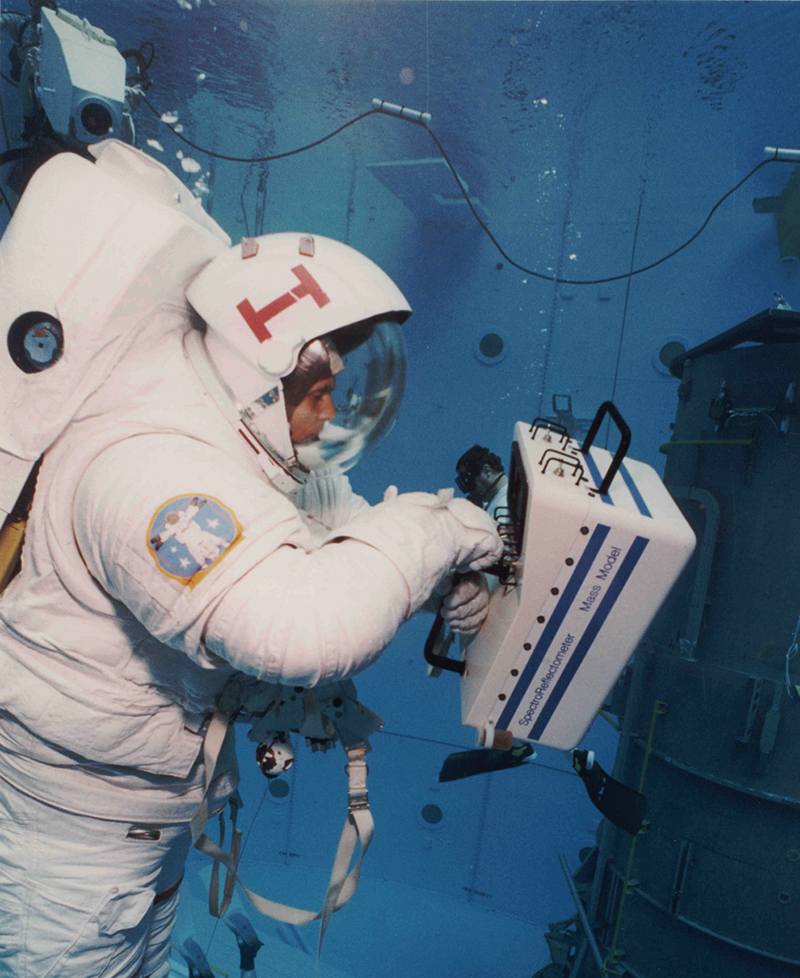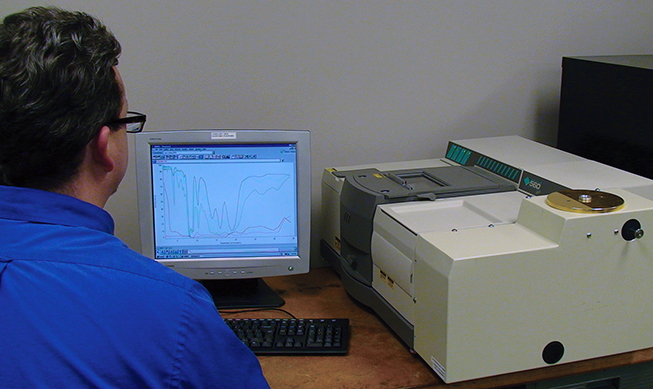
Compact Instruments Measure Heat Potential
Originating Technology/NASA Contribution
Without the insulating protection of Earth’s atmosphere, orbiting space shuttles, space stations, and satellites are subject to thermal damage from radiation. This damage varies with different orbital parameters, solar activity, and the vehicle’s angle to the Sun, so these external surfaces must be designed to resist degradation and protect payloads (and crew) in these varying conditions.
When designing space vehicles and structures, it is important to know how effectively materials will heat or cool a system, and how much they change while in use. Spectral reflectometers, which measure these thermal properties, determine how well a surface absorbs, reflects, emits, or radiates heat. When measuring the surface properties of a material that will be used in space, scientists have traditionally used reflectometers with integrating spheres (also called Ulbricht spheres), which are best suited for the solar spectrum where radiation is hemispherical and the heat sink is all-encompassing, as is the case in space.
In the 1980s, NASA sought an instrument that astronauts could carry on extravehicular activities (EVAs) to assess conditions of external surfaces on space shuttles and space stations. NASA has also used these devices to assess spacecraft instruments and coatings prior to launch to ensure proper thermal properties.
Partnership
A woman- and veteran-owned small business with 35 employees, AZ Technology Inc. offers expertise in electromechanical-optical design and advanced coatings. It sells several portable instruments for measuring different optical properties, including solar absorptance, reflectance, transmittance, and emittance. Based in Huntsville, Alabama, AZ Technology has received eight Small Business Innovation Research (SBIR) contracts with Marshall Space Flight Center for the development of spectral reflectometers and the measurement of surface thermal properties.
Marshall awarded AZ Technology its first NASA contract in 1989 to develop a space-portable spectral reflectometer (SPSR), a hand-held instrument for measuring the thermal properties of surfaces in space. The SPSR was transported to the Mir space station on STS-86, and then used in EVAs to assess the optical performance of external spacecraft radiation tiles. Based on its experience with the SPSR, AZ Technology then entered into a dual-use agreement with Kennedy Space Center for the development of another portable reflectometer, the Total Emittance and Solar Absorption (TESA) instrument, featured in Spinoff 1999.
AZ Technology has also received funding from a Phase III SBIR to develop its Spectrafire laboratory-based spectral emissometer. Recently, the company adapted the Spectrafire into a high-temperature spectral emissometer for Marshall, where it is being used to evaluate ablative materials and emittance characterizations of rocket nozzle designs. The company has also been awarded several SBIRs relating to thermal coatings, which continue to develop concurrently with the company’s expertise in thermal design and instrumentation.
Product Outcome
At ambient conditions, typically near room temperature, most energy transfer is in the infrared spectrum. The materials used to make good integrating spheres—useful for the solar spectrum—do not work well for the infrared spectrum on Earth. To work around bandpass limitations and the need for special calibrations, among other issues, AZ Technology engineers created the Spectrafire with an ellipsoidal collector. This type of collector allows several advantages over an integrating sphere.
David Crandall, AZ Technology’s executive vice president in instruments and engineering services, explains that the ellipsoidal collector allows the Spectrafire to take full advantage of extended spectral ranges. When the Spectrafire is used with a Fourier transform interferometer, spectral total hemispherical reflectance can be measured and, from that, optical properties from the ultraviolet range through far infrared can be calculated.
In this configuration, the Spectrafire can predict emittance at temperatures outside of ambient range: “On a regular basis, we see good projections up to 600 °C,” Crandall says.
Another advantage, Crandall explains, is that the measurement is absolute, and not relative, so there is no operator calibration required for normal emittance. Traditional emittance measurement systems required calibration, often multiple times a day.
In the infrared region there is a loss of energy, which presents a limitation for integrating sphere-based systems. By design, energy that is collected in an integrating sphere is reflected many times before it reaches the detector, causing loss. If a sphere liner is 95-percent reflective, after two reflections, only 90 percent of the energy would remain, and after 14 reflections, more than half of the energy would be absorbed. With an ellipsoidal collector, as is used in the Spectrafire, this is not a problem. There is only one reflection off the collector wall, so the energy throughput is far better. Also, the collector is considerably smaller than an equivalent integrating sphere, which enables the Spectrafire to be even smaller than its predecessors.
Using the Spectrafire, AZ Technology is also able to determine the transmittance of thin materials, such as frosted glass and translucent polymer films. Typically, conventional instruments measure specular transmissions and can measure the transmittance of clear glass, but translucent materials are problematic because they scatter energy; this results in erroneous measurements. The Spectrafire is able to account for that scattering and provide accurate information about the optical properties of translucent materials.
The development of Spectrafire and AZ Technology’s ability to generate spectral reflectance and emittance measurements, Crandall says, enabled the company to begin offering unique services to industry. In 2007, the company used Spectrafire when providing measurement services to General Electric Company (GE) for the design of its Giraffe Warmer for newborns in neonatal intensive care units. “We made suggestions on how they could tailor the emittance with changes in materials and surface finishes,” Crandall says. The device incorporates a heat source that shines onto a reflector. “And that reflector has to emit properly to maintain that baby’s temperature,” explains Crandall. “They had a thermal designer, but he had to know the emittance, and we were able to provide that.” The Giraffe Warmer won the 2008 “Medical Design Excellence Award.”
Thanks to the core competencies developed through its long line of contracts with NASA, AZ Technology sells several other optical measurement tools for field and laboratory use. The TEMP 2000A, for which the company also received NASA funding, has been used to qualify heat exchanger pipe coatings in solar collectors and roofing materials for ENERGY STAR designation. Additionally, the company also qualifies reflectors for infrared camera systems and black baffle coatings for infrared optical systems. Lastly, because of its unique expertise, AZ Technology develops calibration standards for instrumentation, including emissometers and scatterometers. In addition to its optical measurement tools and services, AZ Technology sells thermal control coatings, which have also been developed with NASA funding.
Giraffe™ is a trademark of Datex-Ohmeda Inc.
ENERGY STAR® is a registered mark owned by the U.S. Government.

Shown attached to a personal computer for processing, the Spectrafire is an emissometer that uses an ellipsoidal collector, which allows this bench unit to be smaller than its predecessors.

During training exercies, an astronaut uses a mockup of a space-portable spectral reflectometer, an instrument for measuring the thermal properties of surfaces in space.













